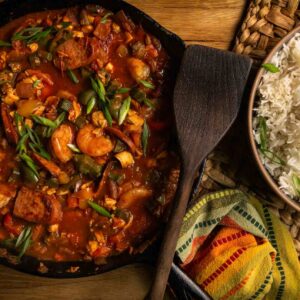
Jack Hennessy grew up in the South Suburbs of Chicago…
A flavorful blend of upland bird meat, shrimp, and andouille sausage inspired by traditional Creole jambalaya
Jambalaya originated in Louisiana. This dish owes its creation and inspiration to African, French, and Spanish cuisines. As I understand it, jambalaya can be either Cajun or Creole, with the deciding factor being whether tomatoes are included. This variation contains tomatoes, so it must be Creole.
Regardless of whether it’s Cajun or Creole, Jambalaya is a staple dish in New Orleans’s French Quarter, home of the Mardi Gras carnival each spring. Why not treat your tastebuds to some of the festivities?
An Upland-inspired Jambalaya
According to various sources, the word “jambalaya” loosely translates to “mishmash” or “mix-up.” It only makes sense to incorporate some upland bird meat into a dish alongside the andouille sausage and shrimp.
Upland Bird Meat Care
Any upland bird meat will work here, but for this particular version, I used two pheasant breasts. The meat can be skinned or plucked. Cook the bird cuts whole as opposed to dicing them and then cooking. Cooking breasts whole, allowing them to rest, and letting the juices redistribute and settle in between muscle fibers will retain more juiciness. Chopping the meat before cooking allows that moisture to seep away.
Brining is also a great option ahead of cooking wild birds. Doing so not only imbues the meat with more flavor, but it also helps retain moisture while cooking. Yes, it will slightly neutralize some of the wilder flavor tones of some meat, but not extensively so. Brining will also assist in removing any residual blood in the meat and simply result in a cleaner-tasting cut.
Spiciness
The level of spice you want to incorporate here is entirely up to you. Serrano peppers aren’t as spicy as jalapeños. Whatever pepper you choose, remember the heat lies in the pulp and the seeds. If you wish to retain just the slightest hint of heat but also incorporate the flavor of a pepper, always remove the seeds and pulp. (You may want to wear gloves while doing so.) If you want to keep that spice level for which peppers are famous, make sure to include the pulp and seeds in your jambalaya.
Homemade Stock
Lastly, homemade stock makes all the difference for dishes like this, and especially for soups. Do yourself a huge favor—and use more of the birds you harvest—and save their bones and carcasses to make stock or broth. You can always freeze or can stock so it stays good for quite some time.

Upland Jambalaya
Ingredients
- 2 pheasant breasts brined and grilled
- 8 oz jumbo or extra-large shrimp shell on
- 8 oz andouille sausage grilled and sliced
- Avocado oil or other high-heat cooking oil
- 1 medium yellow onion chopped
- 3 ribs celery chopped
- 1 yellow bell pepper chopped
- 1 red bell pepper chopped
- 10-12 fingers okra sliced
- 1-3 jalapeño or serrano peppers sliced
- Kosher salt
- Black pepper freshly cracked
- 2 tsp garlic freshly minced
- ½ cup sweet white wine
- 15 oz crushed tomatoes
- 2 cups pheasant stock or chicken stock
- 1 tbsp Cajun spice blend such as Bearded Butchers
- 3 sprigs fresh thyme
- 1½ cups long-grain white rice
- 2 cups cold water
- Sliced scallions for garnish
Instructions
- Brine the pheasant breasts or similar-sized upland bird meat (for a total of approximately 8 ounces) for 8 to 12 hours prior to cooking. Remember to thoroughly rinse off the brine under cold water. After brining, leave the meat in the fridge, uncovered, for 2 to 3 hours prior to cooking; drier meat makes for a better sear.
- When you are ready to cook, heat a thin layer of cooking oil in a large, deep skillet on medium heat. Sear pheasant breasts until golden on both sides then remove, set aside and cover.
- Slice sausage to quarter-inch thickness and add to skillet. Sear both sides and remove.
- Drizzle in a bit more cooking oil, then add the chopped onions. Lightly salt and pepper them and turn heat to medium-high. Stir the onions in the skillet to adequately deglaze the pan. Pick up any brown bits leftover from cooking the meat.
- When the onions are light brown and slightly soft, add the chopped bell peppers and continue to stir. Once the bell peppers are slightly soft and charred, add the freshly minced garlic and stir for a few minutes. Add the white wine and stir to deglaze.
- Turn the heat to medium low and add the crushed tomatoes, stock, cajun spice blend, and sprigs of fresh thyme. Chop the pheasant breasts and add them to the skillet along with seared sausage. If you’re adding hot peppers, add them now.
- Allow the jambalaya to simmer for 1 hour. After 1 hour, remove thyme sprigs. Slice the okra and add it along with shrimp (still in shell). Stir often until shrimp is fully cooked.
- Add rice plus cold water to a medium saucepan. Cover and bring to a boil. When the pot starts to boil, turn the heat to low. Remove the lid briefly and allow it to vent for 5 minutes. After that, return the lid to the pan. Turn off the heat once most of the water is absorbed into the rice.
- To serve, you may wish to remove the shells and tails from the shrimp, then return them to the skillet prior to plating. Each plate can start with a scoop of rice. Top with a large helping of jambalaya. Garnish with sliced fresh scallions. Enjoy!
Nutrition
Jack Hennessy grew up in the South Suburbs of Chicago and didn't start hunting until he attended graduate school in Spokane, Washington, at the age of 26. Hennessy began work in professional kitchens in high school but didn't start writing wild game recipes until he joined the Spokesman-Review in 2014. Since then, his recipes have appeared with Petersen's Hunting, Backcountry Journal, Gun Dog Magazine, among many others. He now lives with his Wirehaired Vizsla, Dudley, in Wichita, Kansas.



